No One Will Tell You This About Running an Online Store
Introduction

You’ve probably read the encouraging stories: “From garage startup to six‑figure‑earnings in six months.” Running an online store promises flexibility, independence, and – if done right – serious income. But the truth is more nuanced. No one will tell you this about running an online store: the behind‑the‑scenes work is tougher, grittier, and often much less glamorous than the polished success stories suggest.
In this post, you’ll get the real scoop. We’ll walk through a step‑by‑step guide to what it really takes, highlight the hidden pitfalls most rookies don’t anticipate, and answer the most frequently asked questions. Consider this your honest roadmap to sustainable success in e‑commerce — without any sugar‑coating.
Step‑by‑Step Guide: What No One Tells You
1. Validate Your Niche And Audience—Properly
Many jump in without truly understanding who they’re selling to. A poor understanding of your target audience can tank your marketing and messaging before you even start .

-
Do surveys, polls, social listening.
-
Develop customer personas (age, income, motivators).
-
Test small campaigns or pre‑orders to ensure demand.
2. Choose The Right Platform – It Matters More Than You Think
Your choice of platform (Shopify, WooCommerce, Squarespace, BigCommerce, etc.) can make or break operational efficiency. The wrong pick leads to headaches over flexibility, fees, and scalability.
-
Compare platforms on ease of use, support, transaction fees.
-
Consider long‑term growth—not just upfront cost.
3. Manage Inventory And Fulfillment—Expect Headaches
More commerce mistakes arise from inventory mismanagement than poor product images. Running out of stock or overselling damages reputation and cash flow.
-
Use inventory‑tracking software, set reorder triggers.
-
Plan returns and reverse logistics with clarity.
-
Consider fulfillment partners or dropshipping carefully.
4. SEO & Content Are Non‑Negotiable
You might think paid ads are everything—that’s not the case. Without strong SEO content (blog, detailed product pages, optimized URLs), you’ll bleed budget trying to drive traffic
-
Build content that answers customer questions (“how to use…”, “benefits of…”).
-
Use keyword tools to optimize titles, meta, alt tags.
-
Avoid keyword stuffing—write for people first.
5. User Experience & Checkout Flow Kill Deals
A confusing site, slow page load, forced account creation or clunky checkout—those invisible design mistakes cost conversions every day .
-
Simplify navigation.
-
Enable guest checkout.
-
Ensure site speed is fast (minimize images, use CDN).
6. Marketing Costs Add Up Fast
The idea of “viral growth” is mostly fiction now. Most stores spend 20–25% of revenue on marketing (ads, influencers, SEO) just to stay competitive
-
Budget realistically: paid, organic, affiliate, email.
-
Track ROI per channel.
-
Experiment but don’t overspend on untested tactics.
7. Customer Service Is Your Lifeline
People skip this in the early phase—but complaints, returns, tickets, unhappy customers? They’ll bury you if you’re unprepared .
-
Set expectations: response time, shipping, refund policy.
-
Offer live chat, timely responses.
-
Collect and act on feedback to improve.
8. Security, Compliance, Taxes—and Boring But Vital Stuff
Security breaches, taxes, data privacy laws—they’re rarely discussed but can cripple you legally and financially .
-
Ensure SSL, PCI compliance, secure admin access.
-
Review data sharing with third parties (up to 30% sites leak data).
-
Stay up against local tax laws, especially if you ship internationally.
9. Burnout Happens—Especially If You Do Too Much At Once
Many entrepreneurs burn out from importing endless products or perfecting design endlessly. Launch fast, iterate slow .
-
Focus on a small catalog (<25 SKUs).
-
Launch a prototype store then refine over time.
-
Prioritize mental bandwidth over perfection.
10. Competition Is Fierce And Ever‑Shifting
You’re not just up against local shops—you’re up against global sellers, fast followers, and big brands. Keep adapting .
-
Monitor competitors constantly.
-
Update product lines, copy, pricing to stay relevant.
-
Innovate your service and UX to differentiate.
FAQs: What You Really Want to Know
Q: How long does it take to start earning consistent profits?
A: Most stores don’t see steady profit until 6–12 months in. Early months tend to be investment—platform costs, ads, product testing.
Q: Do I need tons of products to succeed?
A: No—less is often more. Focusing on a tight product set lets you test demand, perfect listings, and avoid overwhelm .
Q: Should I pay for email marketing services and ads at the start?
A: Yes, but strategically: start budget small, measure return, reinvest. Organic traffic and email will reduce ad reliance over time.
Q: How can I reduce chargebacks and refunds?
A: Ensure accurate descriptions, high‑quality photos, transparent shipping info, responsive support. Set clear policies and follow them consistently.
Q: What’s the single most overlooked aspect?
A: Operational logistics—inventory, returns, support, compliance. The shiny storefront is easy—but logistics F‑up is crushing.
Final Thoughts
Here’s what no one will tell you about running an online store: it takes patience, grit, and behind‑the‑scenes resolve. The wins may be slow at first, but they compound when built on solid foundations.
Brace yourself for daily micro‑challenges: competing with giants, balancing budgets, handling logistics, protecting data. But equally, know that with realistic expectations, relentless iteration, and an empathetic, customer‑centered approach, running your own successful online store can bring freedom—and real earnings.
Focus on progress, not perfection. Validate early, optimize constantly, provide excellent service, and always act with integrity. That’s how you build something that lasts—not just something flashy.





